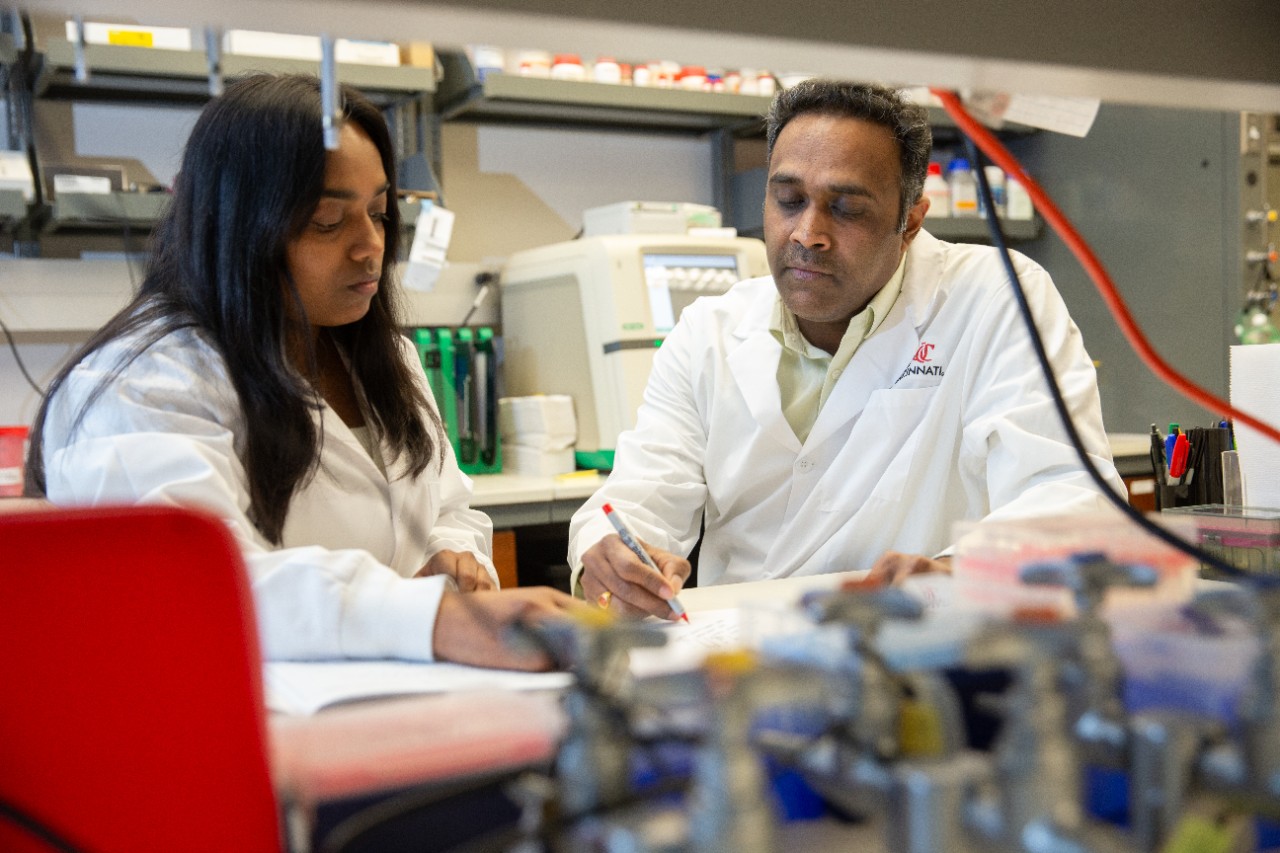
Spectrum News: New study finds molecule to help treat asthma
UC researcher's battle with the condition as a child inspired research
For Satish Madala, MD, of the Division of Pulmonary, Critical Care and Sleep Medicine at the UC College of Medicine, his research into asthma treatments comes from personal experience, having been diagnosed with asthma as a child. He lead a just-published study that identifies a molecule that could lead to improved treatments for asthma.
In an interview with Spectrum News for a story on the study, Madala said, "Asthma usually attacks late in the night. It keeps you awake, it gives you sleepless nights."
Madala says this is because your immune system is trying to fight off allergens.

Satish Madala, PhD, in the Department of Pulmonary, Critical Care and Sleep Medicine at the UC College of Medicine/Photo/Andrew Higley/UC Marketing + Brand
"Your airways become narrow," said Madala. "When they become narrow, you can't take enough of the oxygen you need. So that's why kids cannot sleep, or even adults, when they have an asthma attack, they cannot breathe."
Matish lead a team of doctors and researchers at UC who collaborated with researchers at Cincinnati Children's on a study to help discover better treatment for asthma.
Through their study, they found that a protein called interleukin 31 receptor is what is needed to help people with asthma breathe easier. And now they’re looking to see what other elements are needed to make it effectively work for treatment.
Madala and his team are now trying to figure out what other elements are needed for the treatment to work effectively.
“We need to understand where that binding is happening,” said Madala. “So then we can develop a drug molecule that can prevent that interaction. So that so we can uncouple these interactions that drive that contractility. So then that molecule becomes a therapy for these patients.”
See the entire Spectrum story here.
Read more about Madala's research here.
Lead photo of Madala and graduate student Santhoshi Akkenapally/Andrew Higley/UC Marketing + Brand
Next Lives Here
The University of Cincinnati is classified as a Research 1 institution by the Carnegie Commission and is ranked in the National Science Foundation's Top-35 public research universities. UC's graduate students and faculty investigate problems and innovate solutions with real-world impact. Next Lives Here.
Related Stories
Bono, Chris Tucker Visit UC To Discuss Africa
December 5, 2002
U2's Bono and comedian-actor Chris Tucker led a delegation from the DATA organization who came to UC to talk about potentially catastrophic problems in Africa.
New Year's Help for Those Looking to Kick the Habit
December 20, 2002
Quitting smoking consistently ranks among the top three resolutions made by New Year's resolvers each year.
E-BRIEF: Let's Toast to a Healthier 2003
January 8, 2003
The New Year often means a new health kick: Vows to tone up and trim down, and maybe going to the doctor and getting ourselves as regularly "maintenanced" as we do our cars. So, this week's University of Cincinnati e-briefing examines the health concerns of the young and old, and what you should be doing to preserve your good health.
Today's ML King Events: One On, One Off
January 8, 2003
A memorial march, presentations, poetry and dance will pay tribute to the slain civil rights leader.
UC Named Lead Organization for OSHA Training Consortium
January 13, 2003
UC Continuing Medical Education (CME) has been selected as the lead organization for the Occupational Safety and Health Administration (OSHA) Great Lakes Training Consortium by the U.S. Department of Labor.
Ignorance of Stroke s Warning Signs a Barrier to Treatment; More Education Needed, UC Researchers Report in JAMA
January 13, 2003
Demographic groups facing the greatest risk of death and disability from stroke are the least likely to recognize stroke s warning signs and risk factors, according to a study by UC researchers published in the January 15 issue of the Journal of the American Medical Association (JAMA).
Ignorance of Stroke s Warning Signs a Barrier to Treatment; More Education Needed, UC Researchers Report in JAMA
January 14, 2003
Demographic groups facing the greatest risk of death and disability from stroke are the least likely to recognize stroke s warning signs and risk factors, according to a study by UC researchers published in the January 15 issue of the Journal of the American Medical Association (JAMA).
UC Researchers Find New Link Between the Eye and the Clock in the Brain
January 20, 2003
Results of a study done by a team of researchers working in the laboratories of Michael Lehman, PhD, professor, Department of Cell Biology, Neurobiology, and Anatomy at the UC College of Medicine, will appear in the February issue of Nature Neuroscience.
UC Researchers Find New Link Between the Eye and the Clock in the Brain
January 21, 2003
Results of a study done by a team of researchers working in the laboratories of Michael Lehman, PhD, professor, Department of Cell Biology, Neurobiology, and Anatomy at the UC College of Medicine, will appear in the February issue of Nature Neuroscience.
Leader of Fetal Surgery to Deliver Lectures at UC
January 31, 2003
An internationally recognized authority on fetal surgery will lecture at the UC Medical Center, representing the first of a series of lectures on fetal surgery presented by the department of Obstetrics and Gynecology (Ob/Gyn).
